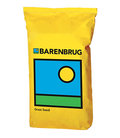Derby County is a cut above the competition with RPR Stadium
Derby County | Seeds of success | RPR STADIUM

Derby County | Seeds of success | RPR STADIUM
Working as a groundsman since he left school at 16, Nathan Scarff knows a thing or three about top-notch turf. In just two years as head groundsman at Pride Park Stadium he’s turned Derby County’s pitch into a playing surface that’s been recognised as the best in the division by the Football League – and made more than £3,500 in cost savings per year in the process.
“I wasn’t happy with the seed I’d inherited and I instinctively knew RPR Stadium was the best choice for us,” says Nathan, who was named Groundsman of the Season in 2015/16 for his work at the Derby County pitch. “I’d trialled several grass seeds while I was at Ipswich Town FC and Barenbrug’s seed always came out on top for wear, winter colour and disease resistance. While other competitor grass seeds performed well in certain areas Barenbrug was an all-round high performer in all categories and my gut instinct told me it was the right one for Pride Park.”
Indeed, despite an increase in the number of games played each season, from 32 in 2014/15 to 40 in 2016/17, the RPR Stadium has continued to perform, showing impressive disease resistance and looking camera ready even after wear and tear – helping secure a ‘Highly Commended’ in the Groundsman of the Season competition this year.
The grass is always greener
Nathan says RPR Stadium’s most impressive features have been the man power and money saved since its introduction.
Rather than a monthly fungicide spray for leaf spot, Nathan’s team now only treats the turf three times a year – saving them around £600 per annum.
“Its disease resistance is fantastic,” says Nathan. “We also spotted some fusarium recently and thought we’d have to treat it, but the next day when we came back to look at it, it had gone. All I can say is that the grass sorted itself out!”.
Liquid fertilizers were also applied to the Pride Park Pitch every month at a cost of around £3,000 per year, but since the introduction of RPR Stadium these have been completely halted.
“I’ve always felt these artificial fertilisers forced the plant along and that it’s much better to look at other things to get the plants in balance,” says Nathan. “The grass grows so well, we don’t need to feed it like we did.”
And, despite heavier usage over the last year, the grass has maintained its fresh appearance and colour without the need for additional ‘greening up’.
Greater flexibility
Aside from the cost savings, Nathan says the improved grass seed has given them greater flexibility.
“Because we don’t have to spray on a regular basis our time has been freed up for other more important tasks, and it’s saved enormously on man hours,” he says. “It’s also had a big impact on the playing side. Players have more confidence because they know that what’s under their feet will allow the ball to run true, and they can turn and pass like the want to without slipping. And the managers are happier, of course, because there’s less risk of injury.”
Despite his success, Nathan is not letting the grass grow under his feet.
“My advice to other groundsmen is to do trials – it’s the only way you can find the best seed for your pitch, and if you sit still the competition will overtake you,” he says. “I like to find small improvements each year, even if it’s just one or two per cent. It adds up to a lot over the year.”

Download the RPR STADIUM brochure for more information.

Recovery time is the real measure of fitness. This mix regenerates to keep your pitch looking its best all season long.